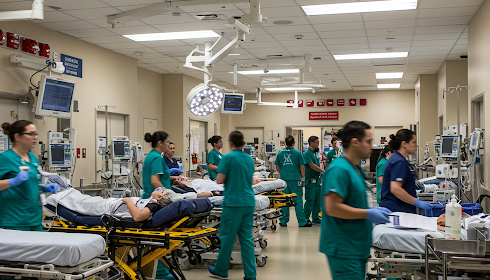
U.S. Hospital Emergency Care Faces Growing Crisis, RAND Report Warns
A recent analysis from the RAND Corporation has highlighted concerns regarding the viability of hospital-based emergency care in the United States. It points to escalating challenges, including the growing complexity of patient needs, decreasing reimbursements for physicians, and an increase in uncompensated care. The study published recently highlights a pressing concern: without immediate action, emergency departments (EDs) may face closures, a shortage of staff, and increasing delays for patients in need of essential care.
The report highlights a resurgence in ED usage, returning to levels seen before the COVID-19 pandemic after a period of limited access during the crisis. Experts highlight that increasing wait times, the practice of patient boarding on emergency department beds, and the strain of uncompensated care are escalating issues that jeopardise the sustainability of these essential services. “Immediate measures are essential to support hospital emergency departments, which serve as a critical resource for patients using these services and the communities that depend on them in times of crisis,” stated Mahshid Abir, the lead author of the report and a senior physician policy researcher at RAND.
The study brings to light a significant concern regarding the absence of direct reimbursement for numerous services offered by emergency departments. Every patient who arrives at an emergency department is required by federal law to undergo evaluation and stabilisation, regardless of their financial situation. Nevertheless, supplementary duties—like organising follow-up care, gearing up for public health crises, and addressing mass casualties—lack direct financial support from both public and private payers. The financial pressure is further intensified by a reduction in payments to emergency physicians. From 2018 to 2022, there was a notable decline in reimbursements from Medicare and Medicaid, which decreased by 3.8%. In contrast, payments for commercially insured visits experienced an even steeper drop—10.9% for in-network visits and an astonishing 48% for out-of-network visits.
The report highlights the changing dynamics of emergency departments in the U.S. healthcare landscape. In addition to conventional emergency services, these departments have evolved into centres that offer a range of innovative solutions, including inpatient observation, hospital-to-home initiatives, remote patient monitoring, and specialised critical care units. Emergency Departments have played a crucial role in tackling significant public health challenges, such as the opioid crisis, gun violence, and the COVID-19 pandemic. Across the nation, emergency departments in hospitals manage between 120 to 140 million visits each year—significantly less than the 1 billion visits to physician offices. However, the closure of these departments, especially in rural regions, has sparked worries regarding access to essential healthcare services.
In response to these challenges, RAND researchers suggest implementing a tiered payment model to enhance the current system. The suggestions put forth involve fresh funding from both public and private insurers to cover unreimbursed public health services, including mental health support and screenings for infectious diseases. The report emphasises the need to enhance Medicaid payments for hospitals that cater to a significant number of uninsured patients, as well as to boost public insurance reimbursements to bridge the disparity with private payers. “If these issues are not tackled, we may see a growing likelihood of emergency departments shutting down, a higher turnover of doctors and nurses in emergency medicine, and patients enduring even longer wait times for care,” Abir cautioned.
The stakes are significant, as emergency departments serve as an essential safety net for communities across the country. The RAND report highlights the urgent need for policymakers and healthcare leaders to respond promptly to rising patient volumes and increasing financial pressures, emphasising the importance of safeguarding this essential element of the U.S. health system.